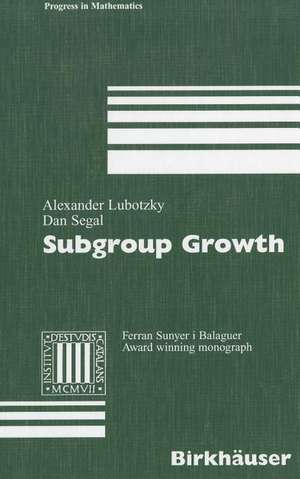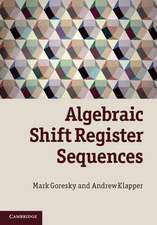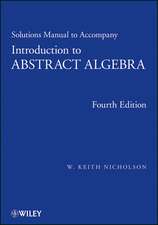Subgroup Growth: Progress in Mathematics, cartea 212
Autor Alexander Lubotzky, Dan Segalen Limba Engleză Hardback – apr 2003
Subgroup growth studies the distribution of subgroups of finite index in a group as a function of the index. In the last two decades this topic has developed into one of the most active areas of research in infinite group theory; this book is a systematic and comprehensive account of the substantial theory which has emerged.
As well as determining the range of possible 'growth types', for finitely generated groups in general and for groups in particular classes such as linear groups, a main focus of the book is on the tight connection between the subgroup growth of a group and its algebraic structure.
A wide range of mathematical disciplines play a significant role in this work: as well as various aspects of infinite group theory, these include finite simple groups and permutation groups, profinite groups, arithmetic groups and Strong Approximation, algebraic and analytic number theory, probability, and p-adic model theory. Relevant aspects of such topics are explained in self-contained 'windows'.
| Toate formatele și edițiile | Preț | Express |
|---|---|---|
| Paperback (1) | 431.94 lei 6-8 săpt. | |
| Birkhäuser Basel – 21 aug 2012 | 431.94 lei 6-8 săpt. | |
| Hardback (1) | 408.86 lei 38-44 zile | |
| Birkhäuser Basel – apr 2003 | 408.86 lei 38-44 zile |
Din seria Progress in Mathematics
- 24%
 Preț: 687.36 lei
Preț: 687.36 lei - 24%
 Preț: 740.80 lei
Preț: 740.80 lei - 9%
 Preț: 763.33 lei
Preț: 763.33 lei -
 Preț: 308.20 lei
Preț: 308.20 lei - 20%
 Preț: 695.88 lei
Preț: 695.88 lei -
 Preț: 362.51 lei
Preț: 362.51 lei -
 Preț: 308.13 lei
Preț: 308.13 lei - 18%
 Preț: 749.27 lei
Preț: 749.27 lei - 9%
 Preț: 766.42 lei
Preț: 766.42 lei - 20%
 Preț: 631.09 lei
Preț: 631.09 lei - 24%
 Preț: 638.88 lei
Preț: 638.88 lei - 15%
 Preț: 580.82 lei
Preț: 580.82 lei -
 Preț: 392.37 lei
Preț: 392.37 lei -
 Preț: 395.09 lei
Preț: 395.09 lei -
 Preț: 390.25 lei
Preț: 390.25 lei -
 Preț: 376.80 lei
Preț: 376.80 lei - 18%
 Preț: 729.53 lei
Preț: 729.53 lei - 15%
 Preț: 652.49 lei
Preț: 652.49 lei - 15%
 Preț: 649.22 lei
Preț: 649.22 lei - 18%
 Preț: 897.95 lei
Preț: 897.95 lei -
 Preț: 385.08 lei
Preț: 385.08 lei -
 Preț: 391.02 lei
Preț: 391.02 lei -
 Preț: 378.54 lei
Preț: 378.54 lei - 15%
 Preț: 531.59 lei
Preț: 531.59 lei - 15%
 Preț: 642.83 lei
Preț: 642.83 lei - 15%
 Preț: 650.69 lei
Preț: 650.69 lei -
 Preț: 381.21 lei
Preț: 381.21 lei -
 Preț: 392.37 lei
Preț: 392.37 lei -
 Preț: 398.53 lei
Preț: 398.53 lei - 15%
 Preț: 699.28 lei
Preț: 699.28 lei -
 Preț: 416.92 lei
Preț: 416.92 lei -
 Preț: 385.84 lei
Preț: 385.84 lei - 18%
 Preț: 902.65 lei
Preț: 902.65 lei - 18%
 Preț: 802.28 lei
Preț: 802.28 lei - 15%
 Preț: 640.06 lei
Preț: 640.06 lei - 18%
 Preț: 1129.83 lei
Preț: 1129.83 lei
Preț: 408.86 lei
Nou
Puncte Express: 613
Preț estimativ în valută:
78.26€ • 85.04$ • 65.78£
78.26€ • 85.04$ • 65.78£
Carte tipărită la comandă
Livrare economică 17-23 aprilie
Preluare comenzi: 021 569.72.76
Specificații
ISBN-13: 9783764369897
ISBN-10: 3764369892
Pagini: 480
Ilustrații: XXII, 454 p.
Dimensiuni: 155 x 235 x 30 mm
Greutate: 0.93 kg
Ediția:2003
Editura: Birkhäuser Basel
Colecția Birkhäuser
Seria Progress in Mathematics
Locul publicării:Basel, Switzerland
ISBN-10: 3764369892
Pagini: 480
Ilustrații: XXII, 454 p.
Dimensiuni: 155 x 235 x 30 mm
Greutate: 0.93 kg
Ediția:2003
Editura: Birkhäuser Basel
Colecția Birkhäuser
Seria Progress in Mathematics
Locul publicării:Basel, Switzerland
Public țintă
ResearchCuprins
0 Introduction and Overview.- 0.1 Preliminary comments and definitions.- 0.2 Overview of the chapters.- 0.3 On CFSG.- 0.4 The windows.- 0.5 The ‘notes’.- 1 Basic Techniques of Subgroup Counting.- 1.1 Permutation representations.- 1.2 Quotients and subgroups.- 1.3 Group extensions.- 1.4 Nilpotent and soluble groups.- 1.5 Abelian groups I.- 1.6 Finite p-groups.- 1.7 Sylow’s theorem.- 1.8 Rest riet ing to soluble subgroups.- 1.9 Applications of the ‘minimal index’.- 1.10 Abelian groups II.- 1.11 Growth types.- Notes.- 2 Free Groups.- 2.1 The subgroup growth of free groups.- 2.2 Subnormal subgroups.- 2.3 Counting d-generator finite groups.- Notes.- 3 Groups with Exponential Subgroup Growth.- 3.1 Upper bounds.- 3.2 Lower bounds.- 3.3 Free pro-p groups.- 3.4 Normal subgroups in free pro-p groups.- 3.5 Relations in p-groups and Lie algebras.- Notes.- 4 Pro-p Groups.- 4.1 Pro-p groups with polynomial subgroup growth.- 4.2 Pro-p groups with slow subgroup growth.- 4.3 The groups $$SL_r^1({\mathbb{F}_p}[[t]])$$.- 4.4 A-perfect groups.- 4.5 The Nottingham group.- 4.6 Finitely presented pro-p groups.- Notes.- 5 Finitely Generated Groups with Polynomial Subgroup Growth.- 5.1 Preliminary observations.- 5.2 Linear groups with PSG.- 5.3 Upper chief factors.- 5.4 Groups of prosoluble type.- 5.5 Groups of finite upper rank.- 5.6 The degree of polynomial subgroup growth.- Notes.- 6 Congruence Subgroups.- 6.1 The characteristic 0 case.- 6.2 The positive characteristic case.- 6.3 Perfect Lie algebras.- 6.4 Normal congruence subgroups.- Notes.- 7 The Generalized Congruence Subgroup Problem.- 7.1 The congruence subgroup problem.- 7.2 Subgroup growth of lattices.- 7.3 Counting hyperbolic manifolds.- Notes.- 8 Linear Groups.- 8.1 Subgroup growth, characteristic 0.- 8.2 Residuallynilpotent groups.- 8.3 Subgroup growth, characteristic p.- 8.4 Normal subgroup growth.- Notes.- 9 Soluble Groups.- 9.1 Metabelian groups.- 9.2 Residually nilpotent groups.- 9.3 Some finitely presented metabelian groups.- 9.4 Normal subgroup growth in metabelian groups.- Notes.- 10 Profinite Groups with Polynomial Subgroup Growth.- 10.1 Upper rank.- 10.2 Profinite groups with wPSG: structure.- 10.3 Quasi-semisimple groups.- 10.4 Profinite groups with wPSG: characterization.- 10.5 Weak PSG = PSG.- Notes.- 11 Probabilistic Methods.- 11.1 The probability measure.- 11.2 Generation probabilities.- 11.3 Maximal subgroups.- 11.4 Further applications.- 11.5 Pro-p groups.- Notes.- 12 Other Growth Conditions.- 12.1 Rank and bounded generation.- 12.2 Adelic groups.- 12.3 The structure of finite linear groups.- 12.4 Composition factors.- 12.5 BG, PIG and subgroup growth.- 12.6 Residually nilpotent groups.- 12.7 Arithmetic groups and the CSP.- 12.8 Examples.- Notes.- 13 The Growth Spectrum.- 13.1 Products of alternating groups.- 13.2 Some finitely generated permutation groups.- 13.3 Some profinite groups with restricted composition factors.- 13.4 Automorphisms of rooted trees.- Notes.- 14 Explicit Formulas and Asymptotics.- 14.1 Free groups and the modular group.- 14.2 Free products of finite groups.- 14.3 Modular subgroup arithmetic.- 14.4 Surface groups.- Notes.- 15 Zeta Functions I: Nilpotent Groups.- 15.1 Local zeta functions as p-adic integrals.- 15.2 Alternative methods.- 15.3 The zeta function of a nilpotent group.- Notes.- 16 Zeta Functions II: p-adic Analytic Groups.- 16.1 Integration on pro-p groups.- 16.2 Counting subgroups in a p-adic analytic group.- 16.3 Counting orbits.- 16.4 Counting p-groups.- Notes.- Windows.- 1 Finite Group Theory.- 2 Finite Simple Groups.- 3 Permutation Groups.- 4 Profinite Groups.- 5 Pro-p Groups.- 6 Soluble Groups.- 7 Linear Groups.- 8 Linearity Conditions for Infinite Groups.- 9 Strong Approximation for Linear Groups.- 10 Primes.- 11 Probability.- 12 p-adic Integrals and Logic.- Open Problems.
Recenzii
Subgroup Growth is an extremely well-written book and is a delight to read. It has a wealth of information making a rich and timely contribution to an emerging area in the theory of groups which has come to be known as Asymptotic Group Theory. This monograph and the challenging open problems with which it concludes are bound to play a fundamental role in the development of the subject for many years to come.
—Journal Indian Inst of Science
"[Subgroup growth] is one of the first books on Asymptotic Group Theory – a new, quickly developing direction in modern mathematics…The book of A. Lubotzky and D.Segal, leading specialists in group theory, answers…questions in a beautiful way .…It was natural to expect a text on the subject that would summarize the achievements in the field and we are very lucky to witness the appearance of this wonderful book. …Readers will be impressed with the encyclopedic scope of the text. It includes all, or almost all, topics related to subgroup growth ….The book also includes plenty of general information on topics that are well known to algebraic audiences and should be part of the background for every modern researcher in mathematics. …a wonderful methodological tool introduced by the authors. …
The book ends [with] a section on open problems, which contains 35 problems related to subgroup growth. The list will be useful and interesting to both established mathematicians and young researchers. There is no doubt that the list includes the most important and illuminating problems in the area, and we eagerly anticipate solutions of at least some of them in the near future.
The book will surely have [a] big impact on all readers interested in Group Theory, as well as in Algebra and Number Theory in general."
—Bulletin of the AMS
"The proofs in this book employ a remarkable variety of tools, from all branches of group theory,certainly, but also from number theory, logic, and analysis…. The authors supply surveys, and some proofs, of necessary results, in the "windows" at the end of the book. These comprise about one quarter of the full book, and they give the needy reader a handy reference, without interrupting the flow of argument in the main text…. Since the subject of this book is an active area of current research, there are many open problems in it…."
—Mathematical Reviews
—Journal Indian Inst of Science
"[Subgroup growth] is one of the first books on Asymptotic Group Theory – a new, quickly developing direction in modern mathematics…The book of A. Lubotzky and D.Segal, leading specialists in group theory, answers…questions in a beautiful way .…It was natural to expect a text on the subject that would summarize the achievements in the field and we are very lucky to witness the appearance of this wonderful book. …Readers will be impressed with the encyclopedic scope of the text. It includes all, or almost all, topics related to subgroup growth ….The book also includes plenty of general information on topics that are well known to algebraic audiences and should be part of the background for every modern researcher in mathematics. …a wonderful methodological tool introduced by the authors. …
The book ends [with] a section on open problems, which contains 35 problems related to subgroup growth. The list will be useful and interesting to both established mathematicians and young researchers. There is no doubt that the list includes the most important and illuminating problems in the area, and we eagerly anticipate solutions of at least some of them in the near future.
The book will surely have [a] big impact on all readers interested in Group Theory, as well as in Algebra and Number Theory in general."
—Bulletin of the AMS
"The proofs in this book employ a remarkable variety of tools, from all branches of group theory,certainly, but also from number theory, logic, and analysis…. The authors supply surveys, and some proofs, of necessary results, in the "windows" at the end of the book. These comprise about one quarter of the full book, and they give the needy reader a handy reference, without interrupting the flow of argument in the main text…. Since the subject of this book is an active area of current research, there are many open problems in it…."
—Mathematical Reviews
Textul de pe ultima copertă
Subgroup growth studies the distribution of subgroups of finite index in a group as a function of the index. In the last two decades this topic has developed into one of the most active areas of research in infinite group theory; this book is a systematic and comprehensive account of the substantial theory which has emerged.
As well as determining the range of possible "growth types", for finitely generated groups in general and for groups in particular classes such as linear groups, a main focus of the book is on the tight connection between the subgroup growth of a group and its algebraic structure. For example the so-called PSG Theorem, proved in Chapter 5, characterizes the groups of polynomial subgroup growth as those which are virtually soluble of finite rank. A key element in the proof is the growth of congruence subgroups in arithmetic groups, a new kind of "non-commutative arithmetic", with applications to the study of lattices in Lie groups. Another kind of non-commutative arithmetic arises with the introduction of subgroup-counting zeta functions; these fascinating and mysterious zeta functions have remarkable applications both to the "arithmetic of subgroup growth" and to the classification of finite p-groups.
A wide range of mathematical disciplines play a significant role in this work: as well as various aspects of infinite group theory, these include finite simple groups and permutation groups, profinite groups, arithmetic groups and strong approximation, algebraic and analytic number theory, probability, and p-adic model theory. Relevant aspects of such topics are explained in self-contained "windows", making the book accessible to a wide mathematical readership. The book concludes with over 60 challenging open problems that will stimulate further research in this rapidly growing subject.
As well as determining the range of possible "growth types", for finitely generated groups in general and for groups in particular classes such as linear groups, a main focus of the book is on the tight connection between the subgroup growth of a group and its algebraic structure. For example the so-called PSG Theorem, proved in Chapter 5, characterizes the groups of polynomial subgroup growth as those which are virtually soluble of finite rank. A key element in the proof is the growth of congruence subgroups in arithmetic groups, a new kind of "non-commutative arithmetic", with applications to the study of lattices in Lie groups. Another kind of non-commutative arithmetic arises with the introduction of subgroup-counting zeta functions; these fascinating and mysterious zeta functions have remarkable applications both to the "arithmetic of subgroup growth" and to the classification of finite p-groups.
A wide range of mathematical disciplines play a significant role in this work: as well as various aspects of infinite group theory, these include finite simple groups and permutation groups, profinite groups, arithmetic groups and strong approximation, algebraic and analytic number theory, probability, and p-adic model theory. Relevant aspects of such topics are explained in self-contained "windows", making the book accessible to a wide mathematical readership. The book concludes with over 60 challenging open problems that will stimulate further research in this rapidly growing subject.
Caracteristici
Awarded with the Ferran Sunyer i Balaguer Prize 2002 Presents a new kind of 'non-commutative arithmetic', with applications to the study of lattices in Lie groups Introduces subgroup-counting zeta functions which have remarkable applications both to the 'arithmetic of subgroup growth' and to the classification of finite p-groups Concludes with a list of over 60 challenging open problems that will stimulate further research in this rapidly growing subject












